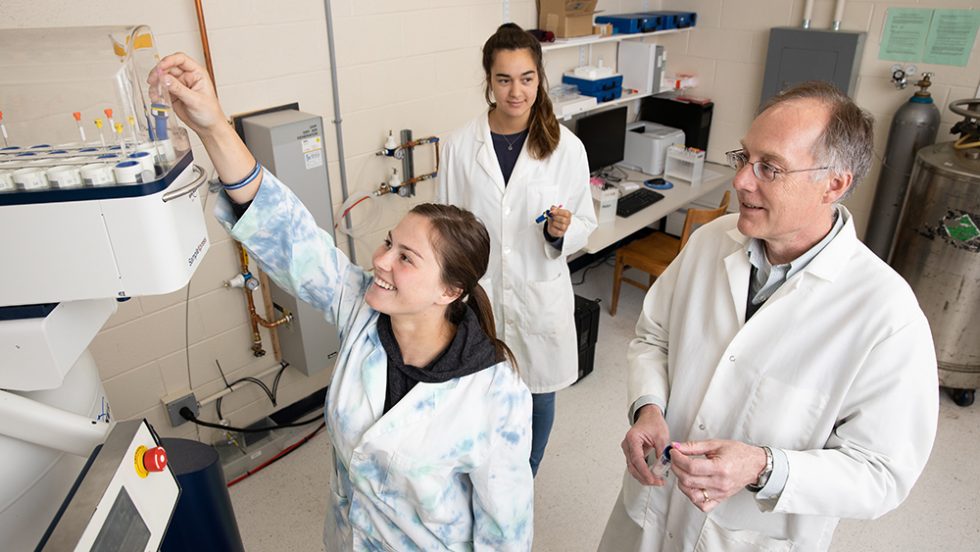
Brian Stockman, PhD, associate professor and chair of the Department of Chemistry and his five collaborating students—Samantha Muellers, Juliana Gonzalez, Abinash Kaur, Vital Sapojnikov and Annie Laurie Benziehas—identified an innovative approach to curing a drug-resistant parasite.
Finding a parasite’s Achilles’ heel: its inability to generate its own nucleobases
The most pervasive nonviral sexually transmitted disease, a parasitic protozoan known as Trichomonas vaginalis (T. vaginalis), poses a deadly and intensifying threat. Already infecting more than 300 million people worldwide, it results in preterm delivery and low birth weights in infants. In adults, it increases the risk of HIV-1 infection and HPV infections that result in prostate or cervical cancer. Perhaps most alarming, T. vaginalis is growing increasingly resistant to the drugs that have been used to treat it for the past 50 years.
The need for a new treatment grows more urgent by the day. “Treatment with a mechanism of action distinct from existing drugs would provide a second line of therapy,” said Brian Stockman, PhD, associate professor and chair of the Department of Chemistry. “It would improve outcomes for the increasing number of patients with drug-resistant T. vaginalis infections.”
After closely studying the protozoan, Dr. Stockman and his five collaborating students—Samantha Muellers, Juliana Gonzalez, Abinash Kaur, Vital Sapojnikov and Annie Laurie Benzie—identified several possible points of attack. “T. vaginalis,” Dr. Stockman explained, “has several Achilles’ heels that can be targeted for the development of new drug treatments.”
He and his lab decided to exploit one particular Achilles’ heel: The parasite is incapable of generating its own nucleobases, the essential building blocks of all genetic code. Without nucleobases, T. vaginalis cannot survive. And because the parasite cannot generate them on its own, “T. vaginalis must scavenge them from host cells using nucleoside salvage pathway enzymes,” Dr. Stockman said.
[pullquote direction=”left”]“T. vaginalis has several Achilles’ heels that can be targeted for the development of new drug treatments.”[/pullquote]
To obstruct that scavenging process, Dr. Stockman decided to target two of T. vaginalis’ enzymes using a fragment-based approach. In what represented the first known application of fragment screening to ribohydrolase enzymes, he would test a diverse set of chemical compounds to see which ones had the intended effect.
“The main challenge for us,” he said, “was getting access to a collection of fragments to screen. We solved this by partnering with AstraZeneca’s Open Innovation platform.” Thanks to this partnership, Dr. Stockman gained access to more than 2,000 compound fragments. After running a series of tests, he and his students identified several promising classes of compounds and published their findings in ACS Infectious Diseases (January 31, 2019).
Now, Dr. Stockman and his collaborators have entered a new stage in the treatment development process. Co-investigator Melissa VanAlstine-Parris, PhD, associate professor of chemistry at Adelphi, will lead the medicinal chemistry phase, working to increase the potency of promising compounds. Dr. Stockman, meanwhile, is immersing himself in new cell culture methods in order to test the most potent compounds later this year.
While the initial results are promising, the future of this research remains unclear. “It will take at least three to four more years to evaluate whether these two enzymes are viable drug targets,” Dr. Stockman said. If they are, in fact, viable, the team will continue the drug development process. If not, Dr. Stockman will shift his focus to other enzymes.
But regardless of how successful these compounds prove, the findings already represent a major breakthrough in our war against drug-resistant diseases. “Our results could provide useful insights for targeting related enzymes,” Dr. Stockman explained, “and the most potent compounds discovered may also be broadly applicable to infections caused by related parasites.” Just which compounds are most useful, however, remains to be seen.
Brian Stockman, PhD, researches biochemistry, biophysics and biomolecular structure. He received a federal grant in 2017 from the National Institutes of Health to immerse undergraduates in hands-on use of the nuclear magnetic resonance (NMR) spectroscopy and researching trichomoniasis.For further information, please contact:
Todd Wilson
Strategic Communications Director
p – 516.237.8634
e – twilson@adelphi.edu